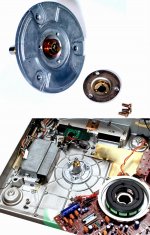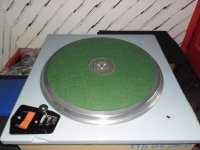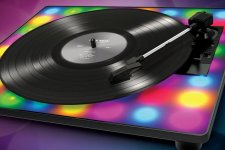SL-10 looks like it uses some sl-1200II+ bits
There is a long restoration thread here, its in Japaneses, but google translate gives the jist most of the time and often with a unintentional touch of humour ...
Hope its the original epc-310mc cart....
There is a long restoration thread here, its in Japaneses, but google translate gives the jist most of the time and often with a unintentional touch of humour ...
Hope its the original epc-310mc cart....
Attachments
My observation:
DD was developed and aimed at dj because of the speed variation, then it entered mainstream, maybe this is a wrong observation, however no belt drive are used in DJ ....
DD are in majority used with a spring platter which wobbles like a warp record, even the most expensive technics have this issue according to many reviewers...
DD have stock lower quality arms and cartridges.
SO, this doesn't mean they are inferior to belt drive, in fact, I am convinced that placing a DD under a belt drive or driving the belt with a DD platter like I saw here, is the equivalent of a heavy platter very costly one with belt drive.
SO, the conclusion, there is more money to make with a belt and heavy platter, the heavier the platter, the more stable the inertia and rotation , then the manufacturers can make huge profits.
This explains why so many people upgrade their DD turntables, however I made my calculations, and the risk of modding/ difficulty, lack of experience made me purchase a belt turn table!
And second conclusion, DD being inferior is just a myth mostly based on the construction, suspension and tone arm quality more than the actual drive system and its excellent performance and low noise.
When I see successful modifs to the DD plater, tone arm, etc I applaud this ingenuity to break the marketing system around audio. (I believe modern tt are engineered to sound not very good and make you want to upgrade and pay for the overpriced ones, they could make a super good belt drive or DD turntable for less than 1K and make plenty of profits)
DD was developed and aimed at dj because of the speed variation, then it entered mainstream, maybe this is a wrong observation, however no belt drive are used in DJ ....
DD are in majority used with a spring platter which wobbles like a warp record, even the most expensive technics have this issue according to many reviewers...
DD have stock lower quality arms and cartridges.
SO, this doesn't mean they are inferior to belt drive, in fact, I am convinced that placing a DD under a belt drive or driving the belt with a DD platter like I saw here, is the equivalent of a heavy platter very costly one with belt drive.
SO, the conclusion, there is more money to make with a belt and heavy platter, the heavier the platter, the more stable the inertia and rotation , then the manufacturers can make huge profits.
This explains why so many people upgrade their DD turntables, however I made my calculations, and the risk of modding/ difficulty, lack of experience made me purchase a belt turn table!
And second conclusion, DD being inferior is just a myth mostly based on the construction, suspension and tone arm quality more than the actual drive system and its excellent performance and low noise.
When I see successful modifs to the DD plater, tone arm, etc I applaud this ingenuity to break the marketing system around audio. (I believe modern tt are engineered to sound not very good and make you want to upgrade and pay for the overpriced ones, they could make a super good belt drive or DD turntable for less than 1K and make plenty of profits)
Last edited:
My observation:
DD was developed and aimed at dj because of the speed variation, then it entered mainstream, maybe this is a wrong observation, however no belt drive are used in DJ ....
DD are in majority used with a spring platter which wobbles like a warp record, even the most expensive technics have this issue according to many reviewers...
DD have stock lower quality arms and cartridges.
SO, this doesn't mean they are inferior to belt drive, in fact, I am convinced that placing a DD under a belt drive or driving the belt with a DD platter like I saw here, is the equivalent of a heavy platter very costly one with belt drive.
SO, the conclusion, there is more money to make with a belt and heavy platter, the heavier the platter, the more stable the inertia and rotation , then the manufacturers can make huge profits.
This explains why so many people upgrade their DD turntables, however I made my calculations, and the risk of modding/ difficulty, lack of experience made me purchase a belt turn table!
And second conclusion, DD being inferior is just a myth mostly based on the construction, suspension and tone arm quality more than the actual drive system and its excellent performance and low noise.
When I see successful modifs to the DD plater, tone arm, etc I applaud this ingenuity to break the marketing system around audio. (I believe modern tt are engineered to sound not very good and make you want to upgrade and pay for the overpriced ones, they could make a super good belt drive or DD turntable for less than 1K and make plenty of profits)
Some facts to bring the stories and myths of DD to clarity.
DD was not originally developed for DJ use, since high quality DD was originally meant for home audio.
DJ's "adopted" the DD machine in the later 1970's, (1977 on) well after the Technics SL-1200's were born.
This is because it was then noticed for its high "startup" ability, useful in doing critical cuing of a song.
But years before, the older DD SL-1100 machines were in homes, as was the superior quality Dual 701 DD machines- about 1973.
And those Dual 701's, if can be found for sale today, are one of the finest machines available, having a 10 LB platter, fully automatic, and have an excellent tonearm as well.
If I could afford one (they seem to go for 500-1000+) I'd be very happy.
Hi,
you could use the 701s drive as donor, upgrading the electronics from the already good emf based regulation to a superior quartz PLL control.
jauu
Calvin
you could use the 701s drive as donor, upgrading the electronics from the already good emf based regulation to a superior quartz PLL control.
jauu
Calvin
Hi,
you could use the 701s drive as donor, upgrading the electronics from the already good emf based regulation to a superior quartz PLL control.
jauu
Calvin
Calvin, trust me, the Dual 701's, once serviced with new capacitors, relubed, cleaned, don't need any "new style" help.
The ones I've serviced are fantastic, solid machines, with stable speeds.
Hi;
No doubt about that 😉
The superiority would probabely only exist on paper not acoustically
jauu
Calvin
No doubt about that 😉
The superiority would probabely only exist on paper not acoustically
jauu
Calvin
gabdx,
you shouldsn't mix alcohol and wacky backy 😱, luckily you had wiseoldtech to straighten things out.
you shouldsn't mix alcohol and wacky backy 😱, luckily you had wiseoldtech to straighten things out.
Compared to my Roksan ANY arm is easy to setup. I'll share the manual with you sometime. Admittedly the 3009 S3 can be fiddly first time but it's all clearly marked on it what does what and the calibrations are accurate.Hi Bill,
Yes, I remember all that stuff. Including how silly some of those arms are to set up. Maybe not to someone who owns one, but all the poor technicians had to deal with every one of them.
. Despite the views of the late Sreten I think the S-arm on my Kenwood is superb. And looks nice.In my opinion, there were some factory arms that were better than the aftermarket ones.
How about the low capacitance cable craze? Not one compensated with the preamp loading, not one. I used to (and still do) measure the capacitance including the preamp input circuitry and pad the missing capacitance in the preamp while explaining the whys and hows of the operation.
A personal bugbear of mine. Most tonearm cabling itself comes to over 100pF, so if you have a 150pF loading requirement (say AT carts) you need very little and the preamp manufacturers don't quote the actual input capacitance of their preamps. Grrrr.
Imo, radio DJs were the original target because they needed a quick spin up speed. Cue the record, talk about it then hit start. It comes up to speed in less than 2 seconds.
Radio DJs need a MUCH faster start up than that. Fractions of a second. Of course Thorens patented direct drive but the SP10 mk1 was first on the market. I don't think any of those made it into radio stations though.
Just for interest, here's a broadcasting stalwart. A 1960s Gates CB500 idler drive transcription turntable.I don't think any of those made it into radio stations though.
This one was brought from America and used by Radio Caroline in the 1980s.
Caroline Turntables
Attachments
BBC Radio one used the Gates idlers in the late 60s and 70s. As far as I can tell they changed to EMT at some point.
I believe it was used in local radio with EMT back in london for the national stations. But the SP10Mk2 wasn't launched until 1975! Certainly I've found one radio 1 photo from 1980 still showing the gates.
gabdx,
you shouldsn't mix alcohol and wacky backy 😱, luckily you had wiseoldtech to straighten things out.
I'm just going from knowledge based on my own past experiences with these things, having been in audio sales in the early/mid -1970's, and also at that time subscribing to various audio magazines with articles of "current trends" in the business.
You see, when you're an older coot like me, having been "in the business" way back, and know what was going on then, and then decades later reading online things that people claim happened which I know did not, I feel compelled to "straighten things out".
A lot of stories these days seem born through myths created by "one person telling another" with some bias thrown in, then that second person adding some more bias, until years later the whole story becomes wildly different than what actually took place.
For instance, the talk about "stacking records on a record changer is bad" came about in the 1950's because someone entering the audio marketplace thought that sales of "single play" manual turntables would be increased if the public were "warned" of damage to records if stacking were done.
Naturally, the public is prone to being "swayed" by advertising claims, as we all know today - including the snake oil sector of marketing.
And the public, being uneducated of the real facts, adopted this way of thinking. - "Oh god forbid!, stacking records is horrible!' - we must get a single-play machine to save our beautiful music!
It's all just hype, nonsense, making manufacturers more money, and keeping the cash flowing into their pockets.
This goes for just about anything as we all know.
Marketing is all about creating fear, and insisting that "bigger is better", "faster is better" and humans are drawn to pretty decorations and lights - superficiality.
Watch in awe as this illuminated turntable puts a new groove in your records! 🙂. . .humans are drawn to pretty decorations and lights. . .
Attachments
The problem with the cheaper BD Project's and to some extents Rega's is the noise coupled from the motor to the platter via the plinth, and through the belt itself. I had a c. £600 Project and bought a special kit for £25 from Henley Designs (the importer) to try to quieten it down. It did reduce the noise but between tracks, the motor came though clearly and I found that unacceptable. If there is one area on these level products that needs attention, its that one in my view.
On more expensive T/T's that have the motor mounted off board like the Michel, and the platter and plinth are very heavy, you have absolute silence - no rumble or motor noise whatsoever.
My Michel sits on a 45 kg Marble headstone (i.e. its what is used on graves) so not much above about 2 or 3 Hz gets up onto the pick-up. Bit heavy to move about mind you 😀
On more expensive T/T's that have the motor mounted off board like the Michel, and the platter and plinth are very heavy, you have absolute silence - no rumble or motor noise whatsoever.
My Michel sits on a 45 kg Marble headstone (i.e. its what is used on graves) so not much above about 2 or 3 Hz gets up onto the pick-up. Bit heavy to move about mind you 😀
Last edited:
Just for interest, here's a broadcasting stalwart. A 1960s Gates CB500 idler drive transcription turntable.
This one was brought from America and used by Radio Caroline in the 1980s.
Caroline Turntables
I love the 'gear' shift.
Watch in awe as this illuminated turntable puts a new groove in your records! 🙂
Yes, that "thing" is one of the things I'm talking about, "glitz and glitter" to make you interested enough to buy that crap.
Pure garbage, aimed at the "stupid" crowd.
- Home
- Source & Line
- Analogue Source
- Turntable DD or Belt drive. This is the question.


